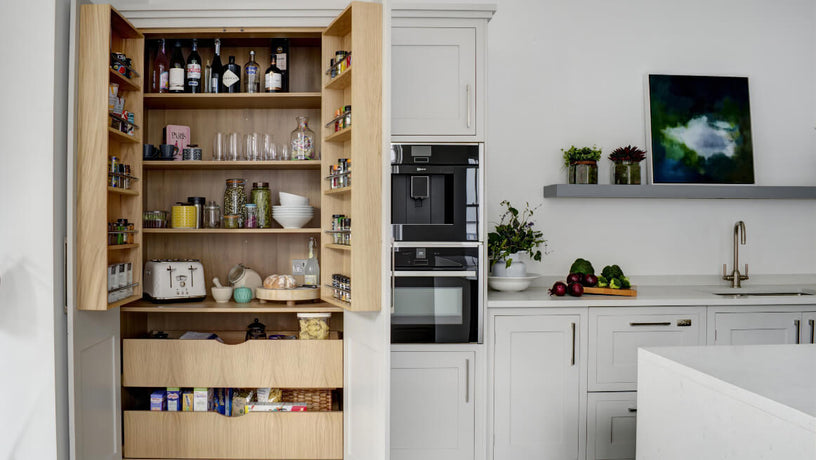- No products in the cart.
THE RENAISSANCE OF LARDERS: REVIVING A TIMELESS TRADITION IN MODERN KITCHENS
07
Feb
In the ever-evolving landscape of kitchen design, certain elements stand the test of time, transcending fleeting trends and fads. Among these enduring features is the larder, a storied and versatile storage solution that has experienced a resurgence in popularity in recent years. This article delves into the rich history of larders, explores their practical benefits, and celebrates their revival as a cherished centerpiece in modern kitchens.
- A Brief History of Larders: From Pantries to Purposeful Storage Spaces
The concept of the larder traces its roots back centuries, to a time when preserving food was a necessity rather than a choice. Early larders served as cool, dark chambers where perishable goods such as meats, dairy, and produce were stored to prolong their shelf life. Over time, larders evolved from simple storage spaces to fully equipped rooms equipped with shelves, hooks, and bins for organizing provisions.
In the Victorian era, larders reached the height of their popularity, becoming an indispensable feature of grand estates and country homes. These expansive rooms were meticulously stocked with provisions, often boasting elaborate shelving systems, marble countertops, and decorative flourishes that reflected the wealth and status of their owners.
- The Practical Benefits of Larders: Preserving Freshness and Promoting Organization
While the days of storing provisions for months on end may be behind us, the practical benefits of larders remain as relevant as ever in modern kitchens. Unlike conventional cabinets and pantries, which can quickly become cluttered and disorganized, larders offer a dedicated space for storing a wide range of perishable and non-perishable items in an orderly fashion.
With ample shelving, drawers, and compartments, larders provide a designated spot for everything from canned goods and dry ingredients to small appliances and kitchen gadgets. This promotes efficiency and ease of access, allowing homeowners to quickly locate ingredients and supplies while cooking or meal prepping.
Moreover, larders are designed to maintain optimal storage conditions for perishable foods, with features such as ventilation, humidity control, and temperature regulation. This helps to prolong the freshness and quality of ingredients, reducing waste and saving money in the long run.
- Design Versatility: Incorporating Larders into Modern Kitchen Aesthetics
In addition to their practical benefits, larders offer endless possibilities for enhancing the aesthetic appeal of the kitchen. Whether your design style is classic and timeless or sleek and contemporary, there are larder options to suit every taste and preference.
For those who favor a traditional look, freestanding larder cabinets with paneled doors and decorative trim evoke a sense of old-world charm and elegance. These units can be finished in rich woods such as oak or walnut for a warm and inviting feel, or painted in soft hues to complement the color palette of the kitchen.
Alternatively, built-in larders offer a seamless and integrated storage solution that blends effortlessly with modern cabinetry and countertops. These units can be customized to match the existing finishes and hardware in the kitchen, creating a cohesive and harmonious look that enhances the overall aesthetic.
- Maximizing Space: Utilizing Larders in Kitchens of All Sizes
In today's homes, where space is often at a premium, larders provide a valuable solution for maximizing storage capacity without sacrificing style or functionality. Whether you're working with a compact galley kitchen or a sprawling open-plan layout, there are larder options to suit every space requirement and layout.
For smaller kitchens, slimline larder units with pull-out shelves or sliding doors offer a space-saving solution that maximizes storage capacity without encroaching on valuable floor space. These units can be tucked into tight corners or recessed into alcoves, making the most of every inch of available space.
In larger kitchens, walk-in larders provide a luxurious and expansive storage solution that can accommodate a vast array of provisions and supplies. These rooms offer ample space for custom shelving, countertops, and storage bins, allowing homeowners to organize and access their kitchen essentials with ease.
- Sustainability and Self-Sufficiency: Embracing the Farm-to-Table Movement
In recent years, there has been a growing emphasis on sustainability and self-sufficiency in the culinary world, with many homeowners seeking to reduce their carbon footprint and embrace the farm-to-table movement. Larders play a crucial role in this ethos, providing a space to store homegrown produce, homemade preserves, and locally sourced ingredients.
By cultivating a well-stocked larder filled with fresh, seasonal ingredients, homeowners can reduce their reliance on packaged and processed foods, while also supporting local farmers and producers. This not only promotes environmental sustainability but also fosters a deeper connection to the food we eat and the land it comes from.
Moreover, larders empower homeowners to take control of their food supply chain, allowing them to preserve and store fruits, vegetables, and herbs from their own gardens or community-supported agriculture programs. This promotes a sense of self-sufficiency and resilience, ensuring that families have access to nutritious and wholesome ingredients year-round.
- Incorporating Modern Conveniences: Upgrading Larders with High-Tech Features
While larders may evoke images of bygone eras, modern advancements in technology have transformed these traditional storage spaces into high-tech hubs of culinary innovation. Today's larders can be equipped with a wide range of features and amenities designed to enhance convenience, efficiency, and connectivity in the kitchen.
For example, refrigerated larders offer a convenient solution for storing perishable items such as dairy, meats, and produce at optimal temperatures, eliminating the need for a separate refrigerator in the kitchen. These units can be integrated seamlessly into cabinetry or positioned as standalone appliances, providing homeowners with flexibility and versatility in their kitchen layout.
Furthermore, smart larders equipped with Wi-Fi connectivity, touch-screen interfaces, and voice-activated controls offer a level of convenience and automation that was once unimaginable. These units can be programmed to track inventory, suggest recipes based on available ingredients, and even place grocery orders online, streamlining meal planning and preparation for busy households.
- Rediscovering the Art of Preserving: Reviving Traditional Cooking Techniques
In addition to their role as storage spaces, larders serve as a hub for rediscovering the art of preserving and traditional cooking techniques. From fermenting and pickling to curing and smoking, these age-old methods of food preservation have experienced a renaissance in recent years, as home cooks seek to reconnect with their culinary roots and embrace the flavors of the past.
By stocking their larders with essential preserving supplies such as mason jars, fermentation crocks, and curing salts, homeowners can embark on a journey of culinary exploration, experimenting with different techniques and recipes to create homemade delicacies that rival those found in gourmet markets and specialty shops.
Moreover, larders provide a space to store homemade preserves, jams, and pickles, allowing them to develop complex flavors and mature over time. This not only adds depth and richness to dishes but also allows homeowners to savor the bounty of the seasons long after they have passed.
- Creating a Sense of Nostalgia: Celebrating the Comforts of Home
In today's fast-paced world, where technology and innovation are omnipresent, larders offer a welcome respite from the hustle and bustle of modern life, evoking a sense of nostalgia and comfort that harkens
For many homeowners, the larder serves as a sanctuary of sorts, a place to escape the chaos of the outside world and immerse oneself in the soothing rituals of food preparation and preservation. Whether it's arranging jars of homemade jams on the shelves or inspecting batches of fermenting vegetables, there's a sense of satisfaction and fulfillment that comes from engaging in these age-old practices.
Moreover, the presence of a well-stocked larder can evoke a sense of comfort and security, knowing that one has a pantry full of provisions to see them through uncertain times. In times of scarcity or crisis, the larder becomes a lifeline, providing sustenance and nourishment when resources are scarce.
In addition to its practical benefits, the larder also serves as a symbol of hospitality and generosity, inviting guests into the heart of the home and offering them a glimpse into the culinary traditions and heritage of the host. Whether it's sharing homemade preserves with neighbors or gifting jars of pickles to friends and family, the larder fosters a sense of community and connection that transcends cultural and social boundaries.
- Incorporating Larders into Modern Lifestyles: Adapting to Changing Needs and Tastes
While the concept of the larder may be rooted in tradition, its revival in modern kitchens is a testament to its enduring relevance and adaptability. Today's homeowners lead busy and dynamic lifestyles, juggling work, family, and social commitments with limited time and resources. As such, the larder has evolved to accommodate the changing needs and tastes of contemporary living.
In urban environments where space is at a premium, compact larder cabinets or pantry pull-outs offer a practical solution for maximizing storage capacity without sacrificing square footage. These streamlined units can be seamlessly integrated into modern kitchen designs, providing a discreet yet functional storage solution for provisions and supplies.
Moreover, the rise of urban gardening and community-supported agriculture programs has sparked a renewed interest in homegrown produce and seasonal cooking, driving demand for larders that can accommodate fresh ingredients and preserve their flavor and quality. From root cellars and cold storage rooms to climate-controlled wine cellars and cheese caves, the possibilities for customizing larders to suit individual tastes and preferences are virtually endless.
- Conclusion: Embracing the Timeless Appeal of Larders in Modern Kitchens
In conclusion, the resurgence of larders in modern kitchens is a testament to their enduring appeal and versatility. From their practical benefits in preserving freshness and promoting organization to their aesthetic charm and nostalgic allure, larders play a central role in enhancing the functionality and ambiance of the home.
Whether you're a culinary enthusiast seeking to embrace traditional cooking techniques or a design aficionado looking to incorporate timeless elements into your kitchen decor, the larder offers a wealth of opportunities for creativity and expression. By celebrating the storied history and rich heritage of larders, we can reconnect with the timeless rhythms of nature and create spaces that nourish the body, mind, and soul.
As we look to the future, the larder stands as a beacon of tradition and resilience, reminding us of the importance of preserving our culinary heritage and embracing the comforts of home. Whether it's stocking shelves with homemade preserves or gathering around the table with loved ones to share a meal, the larder continues to be a cherished centerpiece in the heart of the home, enriching our lives with its timeless charm and enduring beauty.














